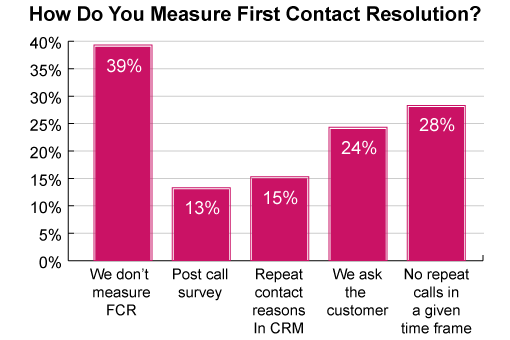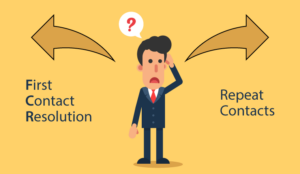We specify the difference between measuring repeat contacts and first contact resolution (FCR) before highlighting why it can be good to do both.
The Difference
FCR measures the percentage of times that a customer contacts the contact centre and gets their query resolved at the first time of asking, whereas repeat contacts is a metric that measures the number of contacts that a customer makes over a certain time period – not necessarily regarding the same issue.
From this distinction, it is clear that there will be a correlation between FCR and repeat contacts, but they are two different metrics.
Yet, according to our 2015 poll, 28% of contact centres measure FCR through repeat contacts in a given timeframe. So, why do contact centres interpret repeat contacts as FCR?

This poll was sourced from our webpage: Over 60% of Contact Centres Measure First Call Resolution
Put simply, repeat contacts is an easy measure to track. At a high level, repeat contacts can easily be extracted from an ACD system to see how many times the same customer has contacted within a fixed period.

Alex Mead
This is according to Alex Mead, Global Customer Service, Experience & Operations Director at Edrington, who says that the better way to measure FCR is through the CRM system instead.
Alex says: “FCR is usually taken from a CRM platform and ideally should only be confirmed as “resolved” when the customer confirms so, not just when an agent says it has been.”
To do this, many contact centres will use a post-contact survey asking; “Did the advisor resolve your call satisfactorily?” However, it’s better to follow up with the customer after a longer period of time, so they have the time to assess whether the advisor’s solution has worked.
For more on the best ways to measure FCR, read our article: How to Calculate First Contact Resolution
Should Repeat Calls Be Factored Into FCR?
No, they are separate metrics, but we can understand the reasoning, especially if it’s the advisor who enters into the CRM if the query has been resolved or not. This is because if the advisor marks the case “resolved”, it doesn’t necessarily mean that it is.
We’re not saying that advisors are purposely doing this to “fake” good FCR results, although this could be the case. Sometimes the customer tries a solution that was given to them by the advisor in good faith, but it doesn’t provide them with a satisfactory result.
When this happens, and the customer calls back – after having their query “falsely resolved”. The second call would not be seen as an extension of the first, even though it technically is.
What I do is send the customer a summary of the contact and what we’ve done, and if they’re not happy, it’s not ‘truly resolved’ and they can reopen the original case. That’s a true FCR measure.
Alex Mead
Yet these concerns don’t mean that it’s good practice to factor in repeat contacts, as Alex Mead adds: “While it’s simple to measure if ‘that’ customer makes contact again, these follow-up contacts are far too often new contacts, which can further distort the FCR numbers. It’s a clear example of theory vs reality.”
“What I do is send the customer a summary of the contact and what we’ve done, and if they’re not happy, it’s not ‘truly resolved’ and they can reopen the original case. That’s a true FCR measure.”
Providing a contact summary can be a great way to measure FCR, but if you’re a large business that cannot automate this process, it is difficult to do this well.
If you are indeed unable to do this, the next best way to measure FCR is to use a dashboard platform – such as Alteryx, Crowdtech or Tableau – that creates maps around specific contact reasons. These maps allow you to see how often the customer has contacted you and what they’ve enquired about – making it possible to calculate FCR in real time.
Why Measure Repeat Contacts?
If you’re measuring FCR, either through call summaries or a dashboard program, is there still reason to measure repeat contacts? Yes, because it’s a measure that gives you different insights from those that you gain through measuring FCR.
Craig Rich, Founder of ThreeDotStudios, explains: “Repeat contacts might be an indication of problems in the ACD, call routing, clarity of messaging, or a number of other areas.”
Repeat contacts might be an indication of problems in the ACD, call routing, clarity of messaging, or a number of other areas.
Craig Rich
One key other area as to why measuring repeat contacts is important is that it helps to give the advisor who is about to receive the customer’s next contact more context.
For example, if the advisor can see, as a call comes in, that the customer has contacted four times previously in the past month, they will be able to change their approach to quickly address any lingering or unresolved issues.

Craig Rich
FCR will not be able to supply this information, but it will provide you with other useful insights.
Craig adds: “FCR is an indication of the capabilities of agents and the effectiveness of knowledge or other systems (if looking at it from an omnichannel perspective).”
With these benefits, FCR is now viewed as the second most important contact centre metric by industry professionals, as reported in our article “The Top 10 Most Important Call Centre Metrics“.
Another key reason for this is because if you can split FCR across a number of different contact reasons, you can prioritise which processes need fixing right away. This means that you can use FCR results to minimise customer effort by removing key moments of friction within the customer experience.
In Summary
FCR is a percentage measure of how often you manage to provide a response that solves the customer’s query at the first time of asking.
Repeat contacts, on the other hand, is a metric of how often a customer contacts you over a certain period of time.
While many contact centres use repeat contacts as an indicator of FCR, it gives a distorted view of FCR, as the customer may well be contacting you about another matter entirely.
So, to measure FCR it’s better to asks customers directly (preferably after a few days, to give them time to “adjust” to the solution) or to use a specialised dashboard platform.
However, this doesn’t mean that it is not valuable to measure repeat calls, as the metric can provide useful information about the proficiency of your ACD system, call routing and clarity of messaging.
On the other hand, FCR provides a separate set of insights, including a view of advisor effectiveness and knowledge, and it also allows you to focus on areas of high customer effort – if the measure is split across different contact reasons.
Author: Robyn Coppell
Published On: 22nd May 2019 - Last modified: 13th Aug 2025
Read more about - Workforce Planning, Alex Mead, Call Handling, First Contact Resolution (FCR), Metrics, Workforce Planning








































